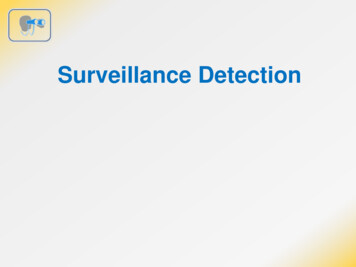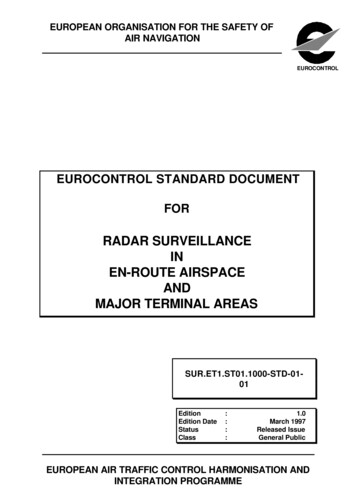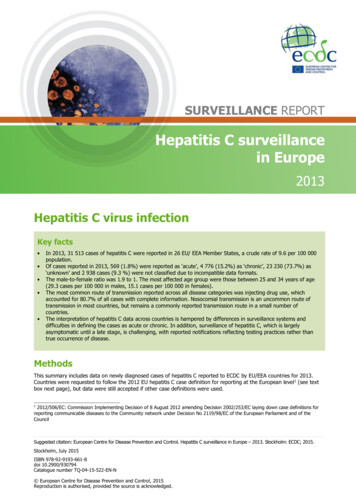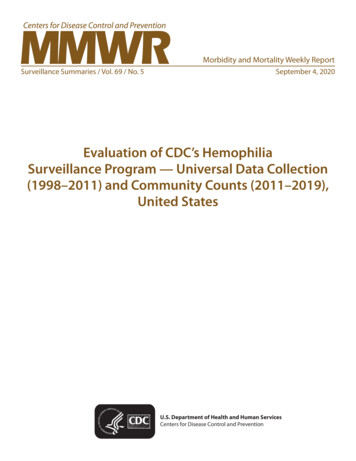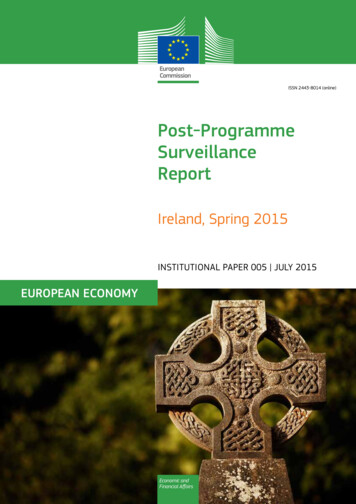
Transcription
ISSN 2443-8014 (online)Post-ProgrammeSurveillanceReportIreland, Spring 2015INSTITUTIONAL PAPER 005 JULY 2015EUROPEAN ECONOMYEconomic andFinancial Affairs
European Economy Institutional Papers are important reports and communications from theEuropean Commission to the Council of the European Union and the European Parliament on theeconomy and economic developments.LEGAL NOTICENeither the European Commission nor any person acting on its behalf may be held responsible forthe use which may be made of the information contained in this publication, or for any errors which,despite careful preparation and checking, may appear.This paper exists in English only and can be downloaded fromhttp://ec.europa.eu/economy finance/publications/.Europe Direct is a service to help you find answersto your questions about the European Union.Freephone number (*):00 800 6 7 8 9 10 11(*) The information given is free, as are most calls (though some operators, phone boxes or hotels may charge you).More information on the European Union is available on http://europa.eu.Luxembourg: Publications Office of the European Union, 2015KC-BC-15-005-EN-N (online)ISBN 978-92-79-48606-7 (online)doi:10.2765/29546 (online)KC-BC-15-005-EN-C (print)ISBN 978-92-79-48605-0 (print)doi:10.2765/518034 (print) European Union, 2015Reproduction is authorised provided the source is acknowledged.
European CommissionDirectorate-General for Economic and Financial AffairsPost-Programme Surveillance ReportIreland, Spring 2015EUROPEAN ECONOMYInstitutional Paper 005
ACKNOWLEDGEMENTSThe report was prepared in the Directorate General for Economic and Financial Affairs under thedirection of Servaas Deroose, Deputy Director-General, István Pál Székely, Director, and Martin Larch,Head of Unit for Ireland at the Directorate-General Economic and Financial Affairs.The main contributors were Stephanie Medina Cas, Quentin Dupriez, Mirzha de Manuel Aramendia,Peter McQuade, Irena Peresa, and Stefano Santacroce. Statistical assistance was provided by JacekSzelożyński. Comments gratefully received from Victor Savin and Rada Tomova (Directorate-GeneralFinancial Stability, Financial Services and Capital Markets Union).The report was prepared in liaison with the European Central Bank.Comments on the report would be gratefully received and should be sent, by mail or e-mail to:Martin LarchEuropean CommissionHead of Unit responsible for Ireland, Lithuania and PolandCHAR 14/174B-1049 BrusselsE-mail: martin.larch@ec.europa.euThe report reflects information available as of June 19, 2015.ii
Executive Summary71.Introduction92.Recent economic developments and outlook102.1.Recent developments102.2.Outlook173.Policy issues263.1.Public finances263.1.1. Buoyant economic growth: opportunity or temptations for fiscal policy?263.1.2. Reinforcing expenditure policies293.2.3.3.4.3.1.3. Policies to broaden the tax base30Macro financial323.2.1. Returning the domestic banks to the private sector323.2.2. Enhancing financial resilience to shocks323.2.3. Reducing the high share of non-performing loans343.2.4. Boosting credit for economic growth36Structural reforms373.3.1. Improving the labour market and addressing skills mismatches373.3.2. Increasing efficiency in the delivery of healthcare373.3.3. Reforming the water sector383.3.4. Reducing legal services costs393.3.5. Privatising non-financial state assets40Financing issues and capacity to repay44A1. State of play with Macroeconomic Imbalance Procedure (MIP) relevantrecommendations46A2. Debt sustainability analysis52A3. Supplementary tables55LIST OF TABLES2.1.Domestic banks' end-2014 performance132.2.Mortgage arrears restructuring targets143
2.3.Financial sector indicators152.4.Main features of the Commission 2015 spring forecast for Ireland203.1.Breakdown of change in the primary expenditure283.2.Average yearly growth of main expenditure items293.3.CBI mortgage regulation rules344.1.Government financing plans45A2.1. Sustainability indicators54A3.1. Fiscal accounts55A3.2. General government debt projections (based on 2015 Spring forecast)56LIST OF GRAPHS2.1.Developments in the construction sector112.2.Recent economic developments162.3.Recent financial developments182.4.Investment in Ireland, recent evolution and forecast192.5.General government deficit: targets and transition from 2014 to 2015213.1.2015 Stability Programme fiscal projections (nominal and structural adjustment)273.2.Expenditure targets (plans, revisions and outturns)30A2.1. Gross government debt projections52LIST OF BOXES42.1.Quarterly National Accounts (QNA) in Ireland222.2.Developments with mortgage arrears in Ireland233.1.Supply-side shortages in the property market413.2.NAMA, the good 'bad bank'42
ABBREVIATIONSAIB: Allied Irish BanksAT1: additional tier oneBOI: Bank of IrelandBTL: buy-to-letCBI: Central Bank of IrelandCCMA: Code of Conduct on Mortgage ArrearsCET1: common equity tier 1CGS: Credit Guarantee SchemeCRD IV: Capital Requirements Directive IVCRE: commercial real estateCRR: Capital Requirements RegulationCSRs: country specific recommendationsDSA: debt sustainability analysisDTAs: deferred tax assetsEC: European CommissionECB European Central BankEDP: Excessive Deficit ProcedureEFSF: European Financial Stability FacilityEFSM: European Financial Stabilisation MechanismESM: European Stability MechanismESRI: Economic and Social Research InstituteETBs: Education and Training BoardsEU: European UnionFDI: foreign direct investmentFET: further education and trainingGDP: gross domestic productGP: general practitionerIBRC: Irish Banking Resolution CorporationIDR: in-depth reviewIMF: International Monetary FundINN: international non-proprietary nameIPHA: Irish Pharmaceutical Healthcare AssociationISI: Insolvency Service of IrelandISIF: Ireland Strategic Investment FundLTI: loan-to-incomeLTV: loan-to-valueMART: Mortgage Arrears Resolution TargetsMDPs: multidisciplinary practicesMIP: Macroeconomic Imbalances ProcedureMNE: multinational enterprisesMTO: medium-term objectiveNAMA: National Asset Management AgencyNESC: National Economic and Social CouncilNFCs: non-financial corporationsNPLs: non-performing loansv
NPRF: National Pensions Reserve FundNTMA: National Treasury Management AgencyPDH: primary dwelling homesPIAs: personal insolvency arrangementsPPM: post-programme monitoringPPS: post-programme surveillancePTSB: Permanent TSBQNA: quarterly national accountsREITs: Real Estate Investment TrustsRWAs: risk-weighted assetsSBCI: The Strategic Banking Corporation of IrelandSCP: Stability and Convergence ProgrammeSGP: Stability and Growth PactSME: small and medium-sized enterpriseSP: Stability ProgrammeSSM: Single Supervisory MechanismTFP: total factor productivityUHI: universal health insuranceUK: United KingdomUS: United StatesVAT: value-added taxyoy: year-on-yearvi
EXECUTIVE SUMMARYThe Irish economy is rebounding strongly yet the legacies of the crisis still call for determinedpolicy efforts in public finances and financial sector repair. Ireland is among the fastest growingeconomies in the euro area due to the improved economic environment and a successful domesticrebalancing with policies to strengthen public finances and repair the banks. Ahead of the nextparliamentary elections, the challenge is to enhance the public debate on prudent fiscal policies andstructural reforms to further reduce high levels of public and private debt and to set the course forbalanced and sustainable economic growth. Despite a recent correction in the European bond markets,yields on Irish government bonds remain historically low. Ireland's financing conditions remaincomfortable, also benefitting from the European Central Bank's (ECB) asset purchase programme.While displaying volatility within the year, economic growth was very strong in 2014. Real grossdomestic product (GDP) is currently estimated to have grown by 4.8% in 2014 due mostly to net exports,which have benefited from improved competitiveness and strong trade links with the UK and USeconomies. Growth was uneven throughout 2014, highlighting the persistent volatility of Irish quarterlyGDP growth rates. This complicates economic monitoring and policy making. While growth in smallopen economies tends to be more volatile, recent studies emphasise that the degree of volatility andfrequency of revisions to Irish national accounts are high, in spite of longer processing times. Moreefforts could be made to explore how to better explain volatility and revisions.The economic recovery is expected to be increasingly driven by domestic demand. From low levels,investment and construction accelerated in 2014, while consumption only picked up towards the end ofthe year. From 12.2% at end-2013, unemployment has continued to decline to 9.8% in May 2015 and isnow well below the euro-area average of 11.1%. Job creation has been across sectors and mostly in fulltime jobs. Real GDP is projected to grow at about 3.5% in 2015 and 2016 with a stronger contributionfrom domestic demand than in previous years. Households should benefit from the growth in employmentand wages, subdued inflation, and improving confidence. Upside economic risks stem from the weak euroand strong activity of multinational companies. Downside risks still emanate from continued debtdeleveraging, which may dampen the recovery in private consumption, a rebound of energy prices andincreased volatility in financial markets.While public finances continue to improve, the 2016 budget deficit target does not fully takeadvantage of strong economic growth. Ireland is on track to correct the excessive deficit in 2015, andthe gross government debt ratio is also expected to decline after having peaked in 2013. Governmentcontingent liabilities related to the National Asset Management Agency (NAMA) have also declined to5.5% of GDP in mid-2015, from 18% of GDP in 2009. For 2016, the Stability Programme (SP) targets adeficit of 1.7% of GDP. Compared to previous government plans, and against the backdrop of a veryrobust growth outlook, the target includes a yet unspecified package of expansionary measures of aroundEUR 1.2 billion or 0.6% of GDP. Reaping the full benefits of the strong growth momentum would avertthe risk of pro-cyclical fiscal policy and create the necessary buffers to address future challenges.The government’s medium-term fiscal strategy still needs to be fully developed. Budgetary plans for2017 onwards in the 2015 Stability Programme are predicated on current policies, while the Stability andGrowth Pact (SGP) requires Member States to present budgetary objectives including a description andquantification of the related measures. Total expenditure is assumed to increase only moderately inabsolute terms, against the backdrop of persisting demographic and wage spending pressures. Accordingto the government’s projections, debt would decline markedly to well below 90% of GDP in the mediumterm. The disposal of the government's equity stakes in the domestic banks, valued at 9% of GDP, wouldfurther contribute to debt reduction. Until then, and with general government gross debt still well aboveGDP, debt dynamics remain sensitive to growth and interest rate shocks.Financial sector reforms continue to advance well, though the durable resolution of non-performingloans (NPLs) requires sustained efforts. As expected, Permanent TSB (PTSB) raised EUR 525 millionin capital from the market at the end of April 2015. This was used to cover the capital shortfall identified7
in the adverse scenario of the stress test under the ECB's comprehensive assessment. The Irishgovernment also sold PTSB shares to lower its stake from 99.2% to 75%. The capital raise generatedstrong international investor appetite and bodes well for the ability of the banks to raise capital and apotential state divestment in Allied Irish Banks (AIB). Though declining gradually, NPLs remain high at23.2% of total loans at end-2014 in the three main domestic banks. Loan restructurings need to accelerateand their sustainability should be continuously monitored. Voluntary engagement between lenders anddebtors in addressing primary-dwelling mortgage arrears has improved, but the legal system slows theresolution process of debts. The use of the new insolvency and bankruptcy framework also remains low,though recent government measures aim to address this problem.Recent mortgage regulations aim to enhance macro-financial resilience, while more needs to bedone to improve bank performance and address supply shortages in the property market. Domesticbanks' profitability has improved but remains challenged. Given the drag of legacy assets and substantialloan arrears, it is important to allow banks sufficient leeway in setting mortgage interest rates. Still,efforts to promote bank transparency in this area are welcome. It is also important to encourage furthercompetition in the banking sector, especially with upcoming bank privatisations Mortgage regulationrules are intended to enhance the resilience of households and banks to financial shocks. Thoughdomestic banks are largely not financing the soaring commercial real estate market, additional regulationsshould be considered here before they do. With supply shortages in Dublin, residential property pricesand rents continue to surge. The authorities are undertaking numerous measures to boost housing supplyand the construction sector. Policies should aim to increase supply more effectively through raising lowprivate-sector financing to developers and revising planning and development regulations.Structural reforms continue to advance, though not all at the same pace. Labour activation reformsare almost finalised as contracts for the provision of support services for long-term job seekers will beginsoon. The authorities plan to launch reviews of several employment support schemes and of Intreo officesto help monitor policy effectiveness. The modernisation of further education and training programmes isprogressing. Further efforts are needed to reduce public expenditure on pharmaceuticals and to improvecost effectiveness in healthcare. The prospects for the enactment of the Legal Services Regulation Bill inthe near term have improved, though a final push will be needed to get it passed without further delays.This would be an important first step towards the reduction of legal services costs. Irish Water has startedsending bills to users, but it is unclear what the level of payment compliance will be. Irish Water isprovisionally classified within general government accounts. The situation regarding the company'sclassification will be clarified at the latest with the publication of Eurostat's Reporting of GovernmentDeficits and Debt Levels in October. It will be important to ensure the company has sufficient funding formuch-needed infrastructure investment.Repayment risks for European Financial Stability Mechanism (EFSM) and European FinancialStability Facility (EFSF) loans remain low. Market access conditions for the Irish sovereign remainfavourable, following policy actions at national and European levels and due to the strong Irish economy.Moreover, cash buffers of the sovereign remain at comfortable levels. In June 2013, the average maturityof EFSM and EFSF loans to Ireland was extended by seven years. The first principal repayments of theEFSF loans are due in 2029, and the EFSM loans principal repayments are not expected before 2027.Annual interest payments on EFSM and EFSF loans both amount to about 0.6% of GDP. Finally, mostoutstanding credits to the International Monetary Fund (IMF) have been repaid.Ireland has made good progress with the 2014 Council recommendations. The specific monitoring ofthe implementation of the Council recommendations under the Macroeconomic Imbalances Procedure(MIP) relies on post-programme surveillance (PPS). Overall, there has been good progress with therelevant country specific recommendations (CSRs): some progress with addressing the fiscal CSR,substantial progress with the CSR on implementation of training and activation programmes, substantialprogress with the CSR regarding measures to boost financing to small and medium-sized enterprises(SMEs) and some progress with the CSR on the restructuring of loans in arrears.8
1.INTRODUCTIONStaff from the European Commission (EC), in liaison with the ECB undertook the third PPS reviewmission for Ireland from 27 April to 1 May 2015. The mission was coordinated with the IMF's postprogramme monitoring (PPM) mission. The European Stability Mechanism (ESM) participated in themeetings on aspects related to its own Early Warning System. As the previous time, the SingleSupervisory Mechanism (SSM) was also represented in the relevant meetings on Irish banks, with stafffrom both the ECB and the national competent authority, the Central Bank of Ireland (CBI). PPS aims ata broad monitoring of economic, fiscal and financial conditions with a view to monitoring the repaymentcapacity of a country having received financial assistance (1). While there is no policy conditionalityunder PPS, the Council can issue recommendations for corrective actions if necessary.In line with the Council conclusions of 2014, the PPS mission encompasses specific monitoring ofthe adjustment of Macroeconomic Imbalances. Under the 2015 European Semester, the results of thein-depth review (IDR) under the MIP for Ireland confirmed that remaining macroeconomic imbalancesrequire decisive policy action and the specific monitoring of the implementation of MIP-tagged CSRs (2).In general, there has been good progress with the relevant CSRs: there has been some progress withaddressing fiscal CSR 1, there has been substantial progress with the CSR 3 on active labour marketpolicies, there have been substantial progress with the CSR 5 regarding improving access to finance toSMEs and there has been some progress with the CSR 6 concerning the restructuring of mortgage loans inarrears. A detailed overview of the progress made with 2014 MIP-tagged CSRs is provided in Annex 1.(1) PPS is foreseen by Article 14 of the two-pack Regulation (EU) N 472/2013. It started after the expiry of the EU/IMF financialassistance programme and lasts until a minimum 75% of the financial assistance has been repaid. (This may be extended wherethere are perceived to be financial difficulties or fiscal instability issues.)(2) See Communication from the Commission to the European Parliament, the Council and the Eurogroup: "2015 EuropeanSemester: Assessment of growth challenges, prevention and correction of macroeconomic imbalances, and results of in-depthreviews under Regulation (EU) No 1176/2011: http://ec.europa.eu/europe2020/pdf/csr2015/cr2015 comm en.pdf9
2.2.1.RECENT ECONOMIC DEVELOPMENTS AND OUTLOOKRECENT DEVELOPMENTSReal GDP grew by 4.8% in 2014 in Ireland. Growth was primarily driven by net exports in the first halfof the year. Quarterly national accounts suggest that economic growth was exceptionally strong in thefirst half of the year and decelerated markedly in the second half, underscoring once again the volatility ofIrish GDP data (Box 2.1 discusses the volatility and revisions of quarterly national accounts). Irelandbenefitted from its improved competitiveness — with a weaker euro, the real effective exchange ratedepreciated by 5% in 2014 and by 21% since 2008 (3) — and strong trade links with the more dynamicUnited Kingdom (UK) and United States' (US) markets. Economic growth was also supported by asizeable contribution from multinational enterprises (MNE), most notably by pharmaceutical companieswhose exports recovered after the expiration of patents in 2013. As a result, total exports grew by 12.6%in 2014 in real terms. However, a substantial proportion of this increase in exports was due to contractmanufacturing which has less impact on tax revenues and jobs in Ireland than indigenous production (4).Imports, which include the inputs used in contracted
Economic and Financial Affairs ISSN 2443-8014 (online) Post-Programme Surveillance Report



